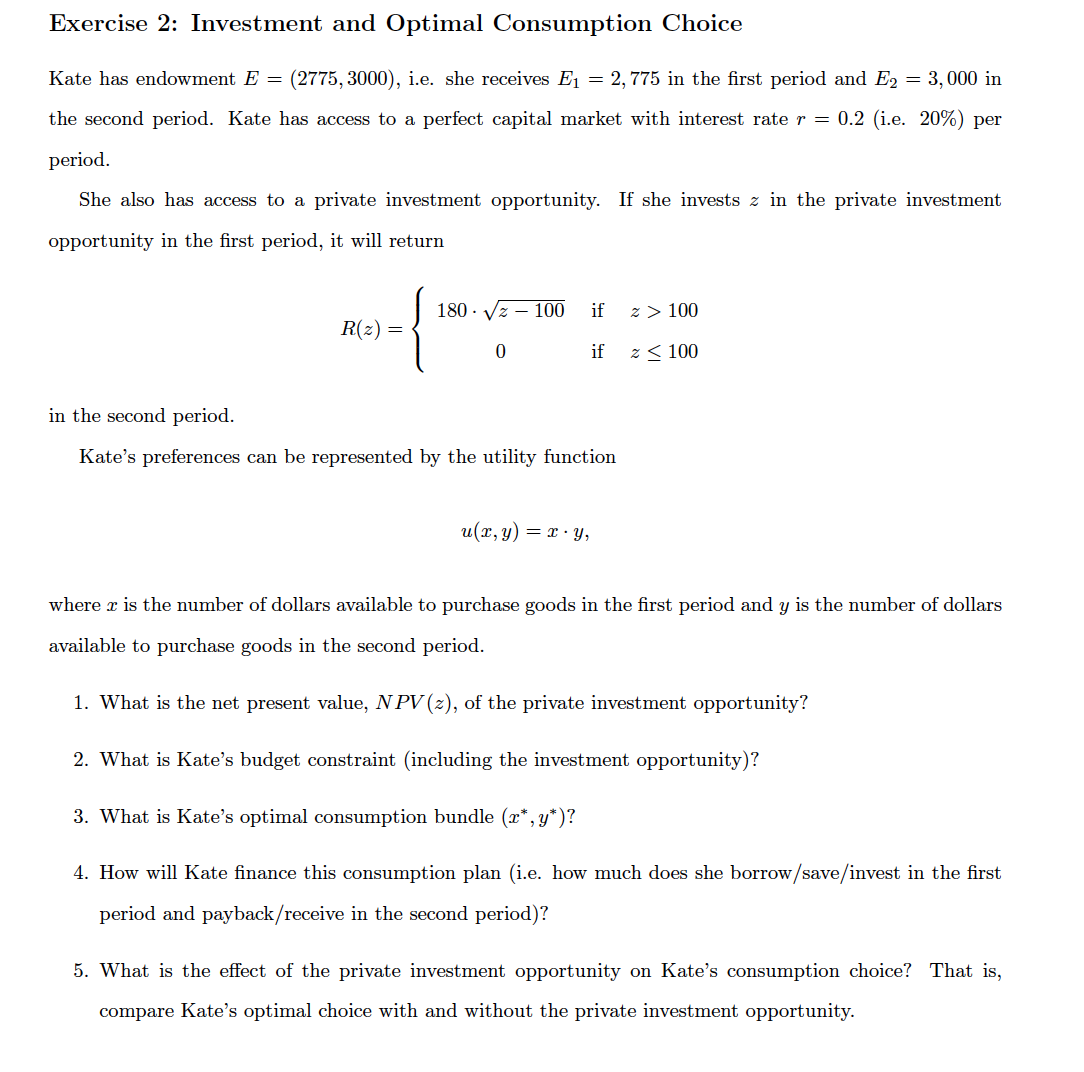Kate has endowment E = (2775, 3000), i.e. she receives E1 = 2, 775 in the first period and E2 = 3,000 in the second period. Kate has access to a perfect capital market with interest rate r = 0.2 (i.e. 20%) per period. She also has access to a private investment opportunity. If she invests z in the private investment opportunity in the first period, it will return 180 - Vz – 100 if z > 100 R(z) = if z< 100 in the second period. Kate's preferences can be represented by the utility function u(x,y) = x · Y, where x is the number of dollars available to purchase goods in the first period and y is the number of dollars available to purchase goods in the second period. 1. What is the net present value, NPV (z), of the private investment opportunity? 2. What is Kate's budget constraint (including the investment opportunity)? 3. What is Kate's optimal consumption bundle (x*, y*)?
Kate has endowment E = (2775, 3000), i.e. she receives E1 = 2, 775 in the first period and E2 = 3,000 in the second period. Kate has access to a perfect capital market with interest rate r = 0.2 (i.e. 20%) per period. She also has access to a private investment opportunity. If she invests z in the private investment opportunity in the first period, it will return 180 - Vz – 100 if z > 100 R(z) = if z< 100 in the second period. Kate's preferences can be represented by the utility function u(x,y) = x · Y, where x is the number of dollars available to purchase goods in the first period and y is the number of dollars available to purchase goods in the second period. 1. What is the net present value, NPV (z), of the private investment opportunity? 2. What is Kate's budget constraint (including the investment opportunity)? 3. What is Kate's optimal consumption bundle (x*, y*)?
Chapter7: Uncertainty
Section: Chapter Questions
Problem 7.10P
Related questions
Question

Transcribed Image Text:Exercise 2: Investment and Optimal Consumption Choice
Kate has endowment E =
(2775, 3000), i.e. she receives E1 = 2,775 in the first period and E2 = 3, 000 in
the second period. Kate has access to a perfect capital market with interest rate r = 0.2 (i.e. 20%) per
period.
She also has access to a private investment opportunity. If she invests z in the private investment
opportunity in the first period, it will return
180 · Vz – 100
if
z > 100
R(z) =
if
z < 100
in the second period.
Kate's preferences can be represented by the utility function
u(x, y) = x · Y,
where x is the number of dollars available to purchase goods in the first period and y is the number of dollars
available to purchase goods in the second period.
1. What is the net present value, N PV (z), of the private investment opportunity?
2. What is Kate's budget constraint (including the investment opportunity)?
3. What is Kate's optimal consumption bundle (x*, y*)?
4. How will Kate finance this consumption plan (i.e. how much does she borrow/save/invest in the first
period and payback/receive in the second period)?
5. What is the effect of the private investment opportunity on Kate's consumption choice? That is,
compare Kate's optimal choice with and without the private investment opportunity.
Expert Solution
Step 1
Given:
E = ( 2775, 3000)
r = 0.2
R(z) = 180. (z-100)1/2 , if z>100
R(z) = 0, if z<100
u = xy
Trending now
This is a popular solution!
Step by step
Solved in 4 steps

Knowledge Booster
Learn more about
Need a deep-dive on the concept behind this application? Look no further. Learn more about this topic, economics and related others by exploring similar questions and additional content below.Recommended textbooks for you


Exploring Economics
Economics
ISBN:
9781544336329
Author:
Robert L. Sexton
Publisher:
SAGE Publications, Inc

Managerial Economics: A Problem Solving Approach
Economics
ISBN:
9781337106665
Author:
Luke M. Froeb, Brian T. McCann, Michael R. Ward, Mike Shor
Publisher:
Cengage Learning


Exploring Economics
Economics
ISBN:
9781544336329
Author:
Robert L. Sexton
Publisher:
SAGE Publications, Inc

Managerial Economics: A Problem Solving Approach
Economics
ISBN:
9781337106665
Author:
Luke M. Froeb, Brian T. McCann, Michael R. Ward, Mike Shor
Publisher:
Cengage Learning